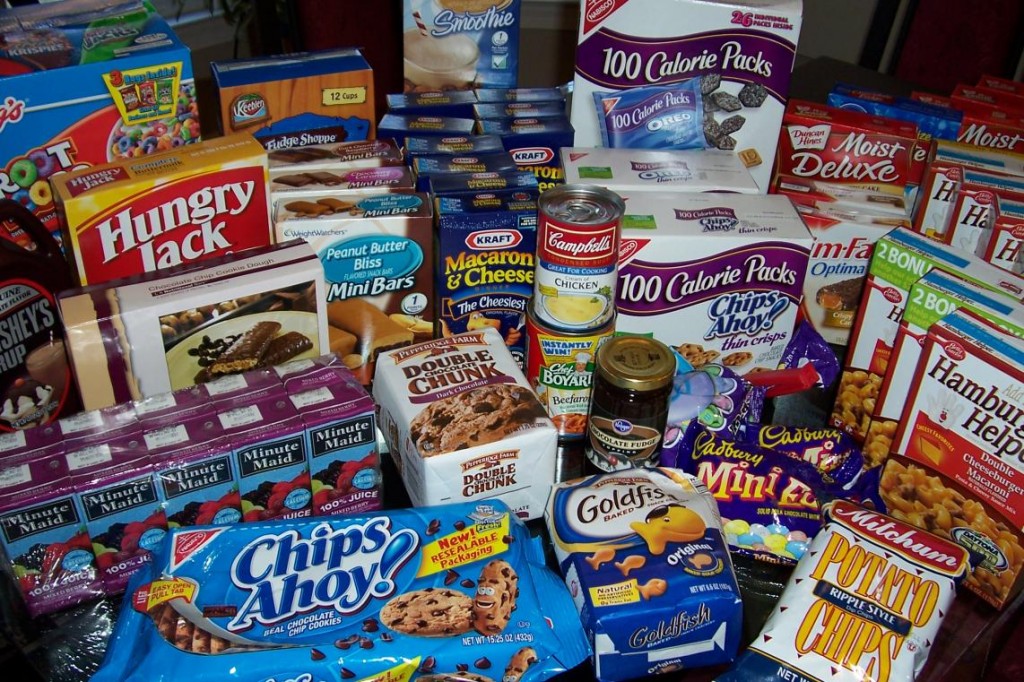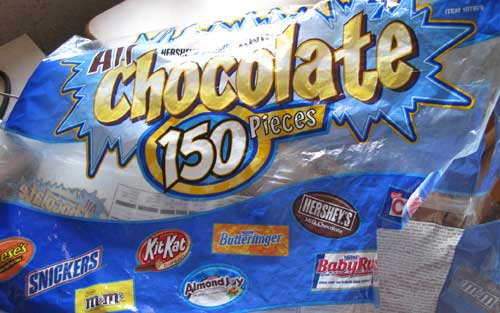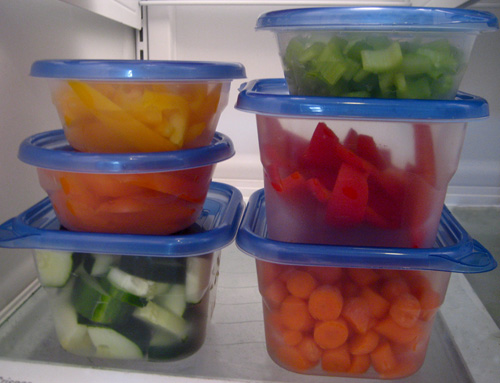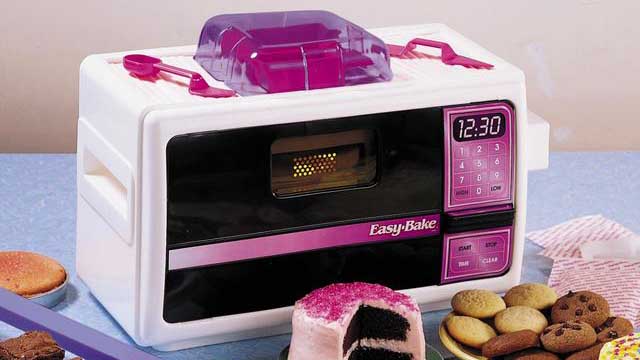In order to get the body you want, you have to surround yourself with good stuff… and purge the stuff that’s holding you back. Get the garbage bags and compost bin ready!
What is a kitchen makeover and why is it important?
“A wise man once said that the kitchen can never be improved upon. Uh… wait a minute… that wasn’t a wise man at all. In fact, I think it was my 8th grade home economics teacher…
Seriously, she said that. And boy was she wrong.” –Ryan D. Andrews
Judging by the number of reality makeover shows out there, everyone loves a makeover. Fresh start, clean slate, ugly duckling to swan, whatever you call it, there’s something exciting about change and improvement.
But we’re not talking about swapping your polka dot curtains and patchwork kitchen floor. Oh no, this is all about Berardi’s First Law:
If a food is in your possession or located in your residence, either you, someone you love, or someone you marginally tolerate will eventually eat it.
In other words, keep only food or drinks that you should actually consume.
If a food and/or drink isn’t conducive to your goals, why would you keep it? Insert defensive, self-justifying excuse here:
- I hate wasting food
- It was on special
- My kid/husband/wife/roommate/dog likes these
- It’s for special occasions (like this Tuesday, when I’ll have a bad day at work)
- Etc.
Folks, please. Get real.
If it isn’t helping you reach your goals, you don’t need it.
A kitchen makeover gets rid of the non-nutritious stuff and/or foods that trigger you to engage in poor eating behaviours. Then it replaces the junk with a bounty of health-promoting foods.
A kitchen makeover helps you stay in control and on track. You don’t want to be deciding between ice cream and spinach while standing in front of the fridge at T-minus 15 minutes to dinner time. Food decisions in our kitchen need to be foolproof.
A kitchen makeover helps you plan and structure healthy eating. You’ll appreciate having a safe home base after returning from the “food war-zone,” also known as modern society.
How to do it
Gather all the unhealthy foods from your fridge and pantry. Get a few big garbage bags.
If a certain food has redeeming qualities, then you can take it to a local food bank or soup kitchen. If it’s complete junk, trash it. Get it out of the house.
If you think it’s junk, it is.
What’s “unhealthy food”? (For that matter, what is “food”?)
Isn’t this a waste of food? Nope. If it’s junk, PN doesn’t consider it “food.” Sorry.
Think about this: Would you dig through a dumpster for dinner? No? Why not? Because the food in there isn’t very good for you. It might be expired, rancid, full of bacteria, or at the very least covered in crud. It’s garbage.
So why would you eat foods that have no nutritional value — and which actively take away from your health? How is that different from dumpster diving?
If you are still in doubt, use these guidelines.
Here’s a general idea of what we mean. Do you have any of the following at home?
Obvious junk foods
- Chips
- Cheezies
- Chocolates or candy
- Soda/pop/sweetened drinks
- Alcohol, especially flavoured/sweetened mixed drinks (although small amounts of red wine may have health benefits)
- Instant foods like cake mixes and mashed potatoes
- Margarine and other processed fats
- Most frozen dinners
- Most take-out or restaurant leftovers
- Bowls of candy or other snacks sitting around
- Flavoured nuts (e.g. beer nuts)
Trick foods
These are foods that seem healthy but aren’t. They’ve gone from something good (whole, unprocessed food) to something that a machine barfed out, something that’s full of sugar and chemicals, and/or something that’s had all its original nutrients stripped out. (No, it’s not “healthy” because it says “fruit”. Check the label.)
- Sweetened yogurt and frozen yogurt
- Breads and bagels, unless they’re made exclusively with whole grains
- Other baked goods
- Breakfast cereals
- Crackers, even the whole grain ones
- Fruit, cereal, and/or granola bars
- Regular peanut butter
- Fruit juice
A good rule here is to check the labels. Look for forms of sugar such as high fructose corn syrup as well as hydrogenated oil, fractioned oil, and preservatives.
And if a product loudly proclaims its health benefits on its label… it’s probably not that good for you. “Organic” sugar is still sugar. A Fruit Roll-Up isn’t an actual piece of fruit any more than a cardboard box is actually a spaceship… no matter how much you pretend.
Stuff you wouldn’t even think about
This is even more challenging than the so-called “healthier” foods in the “trick food” list, because you don’t think about these things being bad for you… or think about them at all. (How much time do you spend thinking about BBQ sauce, anyway?)
Thus, most of these just pass under our radar. Until we read the labels and discover that they’re sugar and chemical bombs. Or just not “food” at all.
- Condiments such as BBQ sauce and other sweetened sauces
- Sweetened relishes, mustards, and ketchup
- Salad dressings
- Bread crumbs, croutons, and other dried bread products
- Processed meats such as hot dogs, bacon, and deli meats
- Spreads such as Cheez Whiz or sweetened cream cheeses
Another way to figure out what you don’t want
When in doubt ask yourself a few questions:
- Does this food come in a bag, box, or plastic package?
- Does it have more than a couple of ingredients on the label?
- Can you pronounce all of those ingredients?
- How far away is this food from what it used to be? (And do you even know what it used to be?)
- Is this food perishable? Just about anything good for you goes bad quickly.
Obviously, there are exceptions, but for the most part, the above foods aren’t a good idea to consume on a regular basis. Why would you want to test your willpower with them around? You might be regretful when you spend your 40th birthday in line at the pharmacy refilling your Lovastatin and Metformin prescriptions. Bummer.
Here is the vast array of “edible food-like substances” to which one of our clients said farewell.

Help! My kitchen’s empty now!
Now your fridge and pantry might look desolate after getting rid of the unhealthy foods. It’s time to fill them back up with healthy replacements for the garbage you just unloaded.
A corollary of Berardi’s First Law is this:
If you wish to be healthy and lean, you must remove all foods not conducive to those goals from said residence and replace them with a variety of better, healthier choices.
In other words, this law works both ways. If the food’s available to you, you’ll eat it.
If an unhealthy food is in your possession, you’ll eat it. If a healthy food is in your possession, you’ll eat it.
All you have to do is make the available food good stuff, and nature takes care of the rest.
Thus, take the restocking process seriously. It’s just as important as the removal process. If your shelves don’t look much different after nixing the junk, then you’re quickly leaving the realm of “nutrition degenerate.” Congrats.
How to restock
Here’s how to quickly restock some nutritious foods (remember not to “over-think” it):
Pick your 3 favorite:
- Vegetables
- Fruits
- Lean proteins
- Nuts/seeds
- Whole grains (oats, quinoa, wild rice, brown rice, sprouted grain breads, corn, amaranth, etc.)
Write them down. We don’t care if they’re frozen or fresh. Just have them on hand so you can actually eat them.
Outside of these staples, any doubts you have about buying certain foods are likely accurate. We’re not saying you should never eat “Food X” again (that decision is up to you), but you may not want to keep the bulk/wholesale four year supply stored on top of the fridge.
This has about 149 too many pieces:

And remember, when you are restocking healthy foods, don’t be fooled by the front of the package. Those darn labels will call out to you with claims like “low-fat,” “no added sugar,” “fat free,” “organic,” “whole grain,” and so on.
Don’t believe it. Keep the ingredients real. Try to shop for seasonal, organic and local food items when possible. You get what you pay for. The fewer ingredients the better (well, except for pixy sticks)!
Check out how simple this restocking process can be based on the following sample shopping lists.
| 3 favourite… | Option 1 | Option 2 |
| Vegetables | Kale Celery Yams |
Spinach Cucumber Squash |
| Fruits | Oranges Pears Apples |
Strawberries Kiwi Cherries |
| Lean proteins | Pinto beans Falafel Hummus |
Organic, free-range eggs Bean burgers Salmon |
| Nuts/seeds | Walnuts Cashew butter Hemp seeds |
Macadamia nuts Almond butter Flax seeds |
| Whole grains | Quinoa flakes Oats Brown rice |
Millet Sprouted grain bread Buckwheat |
Note: Yes – the rest of the family (kids and spouse) can eat these foods too. Why would you feed your family something you wouldn’t eat yourself?
Remember, those are just examples. You could live well into your 90s and still not exhaust all healthy food options.
Now that you have your list, head over to the place that sells food, known as the grocery store. Be on guard: the grocery shopping experience doesn’t end when you unpack your reusable cloth grocery bag at home. The fun is just starting. Wash and cut the veggies and cook the lean proteins and whole grains.
In other words, have the food ready to eat.

Beyond food: The equipment of eating well
Food isn’t the only component of a kitchen makeover, oh no. Having some basic kitchen gear is vital, and Easy Bake Ovens don’t count.

Basic kitchen checklist
- Measuring cups and spoons
- Cookware set
- Knives
- Stainless steel tools and silicon spatula
- Indoor grill
- Wok
- Rice cooker/steamer
- Food processor
- Tea kettle
- Blender
- Cutting board
- Large bowls
- Wooden spoons
- Strainer
- Vegetable peeler
- Graters
- Baking sheets
- Casserole dishes
Summary and recommendations
Healthy eaters have healthy homes. Healthy people ensure that their environment supports their goals. Changing your surroundings is one of the best ways to start your journey to living better.
- Part ways with non-nutritious foods and eliminate anything in your house that doesn’t support your goals.
- Re-stock with healthy options.
- Use a list for your next grocery store visit. Use our suggestions as a guide.
- Also, make sure you have basic kitchen gear to prepare and store your bounty of healthy food.
Follow these steps and you’ll have your kitchen made over in less than 24 hours.
For the step-by-step process of making over your kitchen, use the Precision Nutrition System and the Gourmet Nutrition cookbook.
Extra credit
Keep a running grocery list all week of items you need to replenish.
Stock up on frozen fruits and vegetables so you have a back up when the fresh supply runs out.
Build a kitchen that you enjoy, bring in a stereo, turn on some music that will get you in a good mood. Better mood = better food.
De-clutter. The more space you have in the kitchen, the better. (And the less you have to clean.)
If you like to watch TV, get one for your kitchen. This way you won’t be in a rush.
Keep a large cutting board by the sink. This will allow you to quickly slice and dice veggies.
Keep eco-friendly soap, biodegradable sponges, and clean towels handy to maintain a clean kitchen. Dirty kitchen = potential food poisoning.
References
Click here to view the information sources referenced in this article.
Eat, move, and live… better.©
The health and fitness world can sometimes be a confusing place. But it doesn’t have to be.
Let us help you make sense of it all with this free special report.
In it you’ll learn the best eating, exercise, and lifestyle strategies — unique and personal — for you.




Share